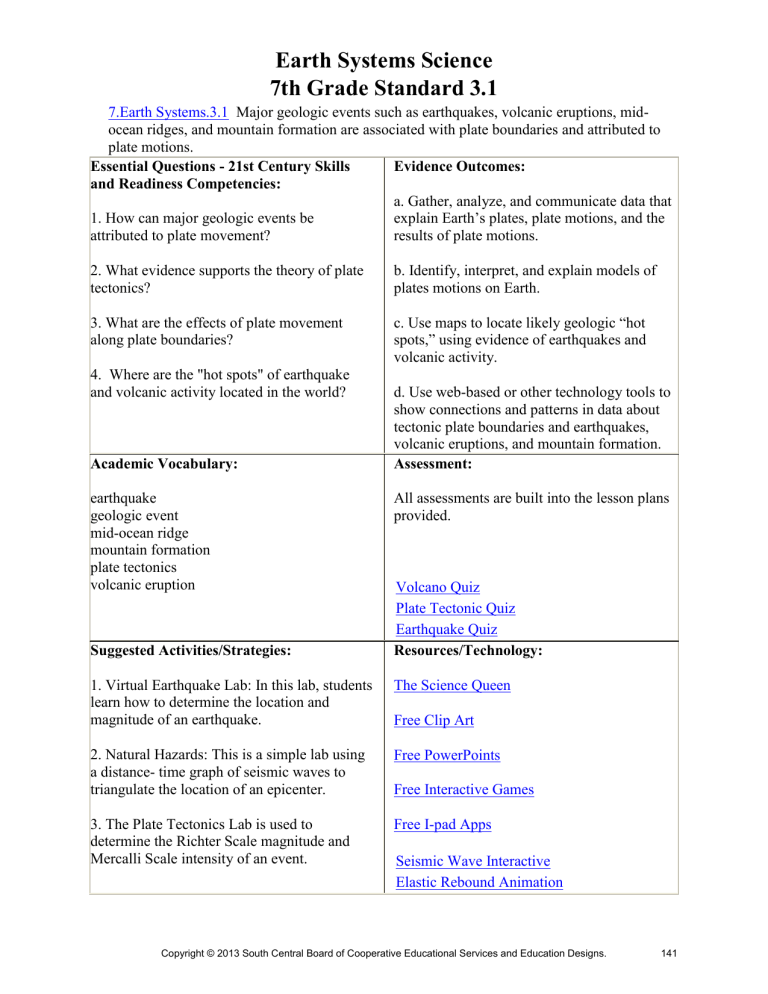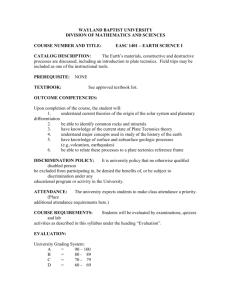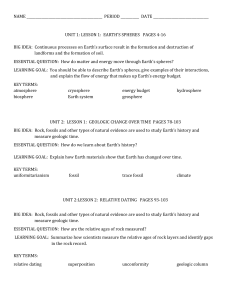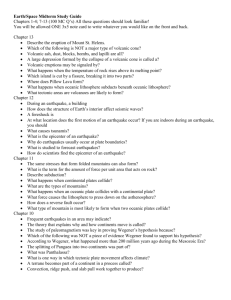Earth Systems Science 7th Grade Standard 3.1

Earth Systems Science
7th Grade Standard 3.1
7.Earth Systems.3.1
Major geologic events such as earthquakes, volcanic eruptions, midocean ridges, and mountain formation are associated with plate boundaries and attributed to plate motions.
Essential Questions - 21st Century Skills and Readiness Competencies:
Evidence Outcomes:
1. How can major geologic events be attributed to plate movement? a. Gather, analyze, and communicate data that explain Earth’s plates, plate motions, and the results of plate motions.
2. What evidence supports the theory of plate tectonics?
3. What are the effects of plate movement along plate boundaries? b. Identify, interpret, and explain models of plates motions on Earth. c. Use maps to locate likely geologic “hot spots,” using evidence of earthquakes and volcanic activity.
4. Where are the "hot spots" of earthquake and volcanic activity located in the world?
Academic Vocabulary: earthquake geologic event mid-ocean ridge mountain formation plate tectonics volcanic eruption d. Use web-based or other technology tools to show connections and patterns in data about tectonic plate boundaries and earthquakes, volcanic eruptions, and mountain formation.
Assessment:
All assessments are built into the lesson plans provided.
Suggested Activities/Strategies:
Volcano Quiz
Plate Tectonic Quiz
Earthquake Quiz
Resources/Technology:
1. Virtual Earthquake Lab: In this lab, students learn how to determine the location and magnitude of an earthquake.
The Science Queen
Free Clip Art
Free PowerPoints 2. Natural Hazards: This is a simple lab using a distance- time graph of seismic waves to triangulate the location of an epicenter.
3. The Plate Tectonics Lab is used to determine the Richter Scale magnitude and
Mercalli Scale intensity of an event.
Free Interactive Games
Free I-pad Apps
Seismic Wave Interactive
Elastic Rebound Animation
Copyright © 2013 South Central Board of Cooperative Educational Services and Education Designs.
141
Earth Systems Science
7th Grade Standard 3.1
4. Mid-ocean Ridge Model: This model is designed to help students understand the movement of the oceanic plates at the midocean Ridge.
Tsunami Animation
Volcanic Eruptions
5. Students build their own seismograph using these directions.
Seismic Waves Resource
Volcano Video
Earthquake PowerPoint
Teaching Earthquakes
Geological Society of America Lesson Plans
6. Earthquake Machine: A block and sandpaper model are used to model friction.
Elastic rebound (release) is used as an example of the interaction between tectonic plates before and after an earthquake.
Earthquake Location PowerPoint
7. World Tectonic Map Activity: The activity uses a simple “Where’s Waldo” approach to identify tectonic symbols on a laminated
World Plate Tectonic map.
8. Use the Teaching about Plate Tectonics and
Faulting Using Foam Models to demonstrate plate tectonic principles, plate boundary interactions, and the geometry and relative motions of faulting in geologic layers.
9. Flour Box Volcano Model: A balloon and a box of flour model a magma chamber and overlying rock.
1. Virtual Earthquake Lab
2. Natural Hazards
3. Plate Tectonics Lab
4. Mid-ocean Ridge Model
5. Build Your Own Seismograph
6. Earthquake Machine
7. World Tectonic Map Activity
7. Poster-size Map of Plates
7. Small World Map
8. Teaching about Faults with Foam Models
9. Flour Box Volcano Model
Copyright © 2013 South Central Board of Cooperative Educational Services and Education Designs.
142
Earth Systems Science
7th Grade Standard 3.2
7.Earth Systems.3.2
Geologic time, history, and changing life forms are indicated by fossils and successive sedimentation, folding, faulting, and uplifting of layers of sedimentary rock.
Essential Questions - 21st Century Skills and Readiness Competencies:
Evidence Outcomes:
1. How can we interpret data from layers of rock? a. Describe the geologic time scale and why it is used.
2. What is geologic time? b. Identify and describe the impact of major geologic events on life on Earth.
3. What is the geologic time scale and why is it used?
4. What are some major events in Earth's geologic history? c. Identify and describe major events in
Earth’s geologic history. d. Use direct and indirect evidence to determine the sequence of events in geologic time.
Assessment: Academic Vocabulary: faulting folding geologic history geologic time sedimentary rock successive sedimentation
Suggested Activities/Strategies:
1. Assessment can either be through teacher observation or after the activity is completed, have the students write a narrative about what they did.
2- 9. All assessments are located within the lesson plans provided.
Resources/Technology:
1. Edible Rock Layer: This is an experiment that simulates the movement, folding, and faulting of rock strata such as sandstone, siltstone, limestone, and shale.
Free Clip Art
Free PowerPoints
Free Interactive Games
2. Have students complete the Determining the
Age of Rocks and Fossils Lab . Free I-pad Apps
3. Who's on First?
Students sequence information using items which overlap specific sets; relate sequencing to the Law of
Superposition; and show how fossils can be used to give relative dates to rock layers.
4. Sedimentary Rock Lesson Plan: Students are introduced to processes that form sedimentary rocks.
Diagram of Folding and Faulting
Create a PowerPoint
Time Line Worksheet
Earth Science Hot List
Geological Society Resources
Earth Science Internet Resources
Copyright © 2013 South Central Board of Cooperative Educational Services and Education Designs.
143
Earth Systems Science
7th Grade Standard 3.2
5. Sedimentary Rock Activity: Facilitate student understanding of sedimentary rocks and their formation.
6. If You Bit a Rock: This lab gives students the opportunity to observe and describe the physical characteristics of a familiar model
(candy bars) and to apply understanding to the unfamiliar (rocks).
7. Rocks Lesson Plan: This lesson was written for lower elementary standards, but can be adapted for use in Grade 7.
8. Geologic Time: This activity helps students to gain a better understanding of the geologic time scale.
9. Towel Geology: Students explore basic stratigraphy, the sequence of rock layers, the formation of unconformities, folding, faulting, uplift, structure of basins, and structural arches.
10. Sedimentary Rock Lesson: Students are introduced to the processes that form sedimentary rocks.
1. Edible Rock Layers
4. Sedimentary Rock Lesson Plan
5. Sedimentary Rock Activity
6. If You Bit a Rock
7. Rocks Lesson Plan
8. Geologic Time
9. Towel Geology
10. Sedimentary Rock Lesson
Copyright © 2013 South Central Board of Cooperative Educational Services and Education Designs.
144







